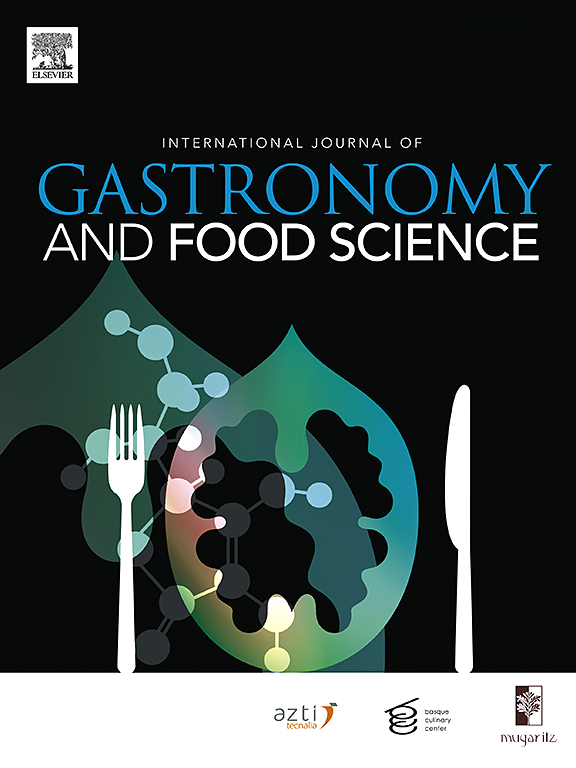Symbiotic honey beverages: A matrix which tells a story of survival and protection of human health from a gastronomic and industrial perspective
IF 3.2
2区 农林科学
Q2 FOOD SCIENCE & TECHNOLOGY
International Journal of Gastronomy and Food Science
Pub Date : 2025-04-09
DOI:10.1016/j.ijgfs.2025.101183
引用次数: 0
Abstract
This review provides an overview of how probiotic honey beverages have been used by humankind throughout history to promote protection of human health. After a brief historical explanation with the main reports involving the use of these beverages for medicinal and conservation purposes, their symbiotic effects and the main physicochemical and microbiological properties reported as benefiting this synergistic effect and also for the control of metabolic syndromes are presented. To this end, the main studies that correlate these inherent properties of the beverages and associate their symbiotic and systemic effects during product storage and when subjected to gastrointestinal conditions are summarized. There is evidence that the physicochemical characteristics of the raw materials used, and especially the properties of the final composition of the beverages, can have positive effects on the health and protection of the host. This observation was possible mainly from experimental studies on prebiotic oligosaccharides, phenolic compounds and short-chain fatty acids. Temperature is highlighted as a crucial extrinsic factor for ensuring the product's viability during storage. The success of these honey-based nutraceutical drinks is due to the close relationship humanity has with honey and its derivatives in different culinary techniques in sweet and Savory preparations, especially when it is culturally well-established for having beneficial properties. Additionally, an analysis is conducted on the future scientific and technological research required to further understand these probiotic beverages, particularly for vulnerable groups such as individuals with metabolic diseases and syndromes regarding immune system modulation.
共生蜂蜜饮料:从美食和工业的角度讲述生存和保护人类健康的故事
本文综述了益生菌蜂蜜饮料在人类历史上是如何被用来促进保护人类健康的。在简要介绍了这些饮料用于药用和保护目的的主要报道之后,介绍了它们的共生作用以及据报道有利于这种协同作用和控制代谢综合征的主要理化和微生物特性。为此,总结了有关饮料这些固有特性的主要研究,以及它们在产品储存和胃肠道疾病期间的共生和系统效应。有证据表明,所用原料的物理化学特性,特别是饮料的最终成分的特性,可以对宿主的健康和保护产生积极的影响。这一发现主要来自于对益生元低聚糖、酚类化合物和短链脂肪酸的实验研究。温度是一个重要的外在因素,以确保产品的生存能力在储存期间。这些以蜂蜜为基础的营养饮料的成功是由于人类与蜂蜜及其衍生物的密切关系,在不同的烹饪技术中,在甜味和咸味的制备中,特别是当它在文化上被公认为具有有益的特性时。此外,还分析了未来需要进行的科学和技术研究,以进一步了解这些益生菌饮料,特别是对易受伤害的群体,如患有代谢疾病和免疫系统调节综合征的个体。
本文章由计算机程序翻译,如有差异,请以英文原文为准。
求助全文
约1分钟内获得全文
求助全文
来源期刊

International Journal of Gastronomy and Food Science
Social Sciences-Cultural Studies
CiteScore
5.30
自引率
10.50%
发文量
170
审稿时长
45 days
期刊介绍:
International Journal of Gastronomy and Food Science is a peer-reviewed journal that explicitly focuses on the interface of food science and gastronomy. Articles focusing only on food science will not be considered. This journal equally encourages both scientists and chefs to publish original scientific papers, review articles and original culinary works. We seek articles with clear evidence of this interaction. From a scientific perspective, this publication aims to become the home for research from the whole community of food science and gastronomy.
IJGFS explores all aspects related to the growing field of the interaction of gastronomy and food science, in areas such as food chemistry, food technology and culinary techniques, food microbiology, genetics, sensory science, neuroscience, psychology, culinary concepts, culinary trends, and gastronomic experience (all the elements that contribute to the appreciation and enjoyment of the meal. Also relevant is research on science-based educational programs in gastronomy, anthropology, gastronomic history and food sociology. All these areas of knowledge are crucial to gastronomy, as they contribute to a better understanding of this broad term and its practical implications for science and society.
 求助内容:
求助内容: 应助结果提醒方式:
应助结果提醒方式:


